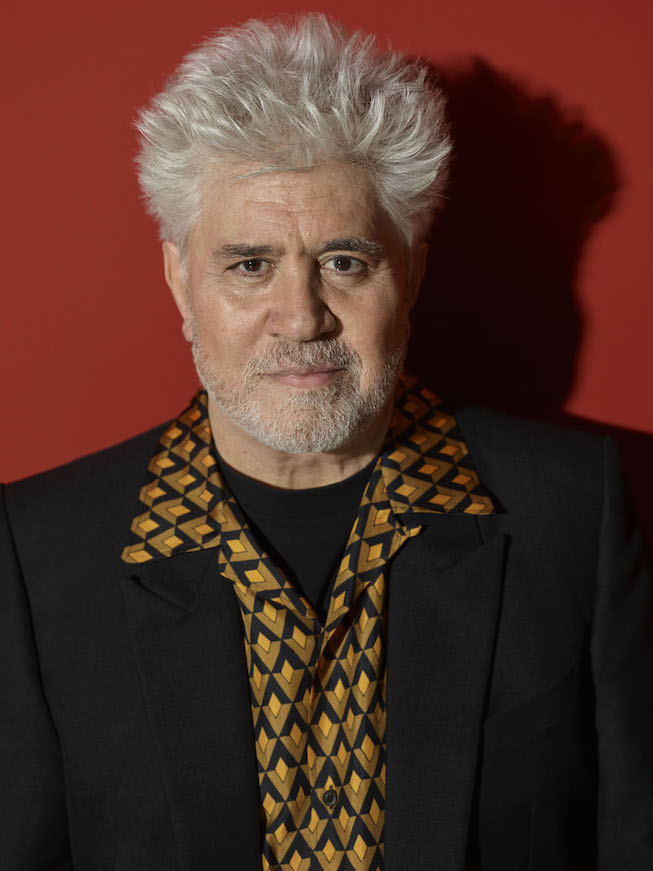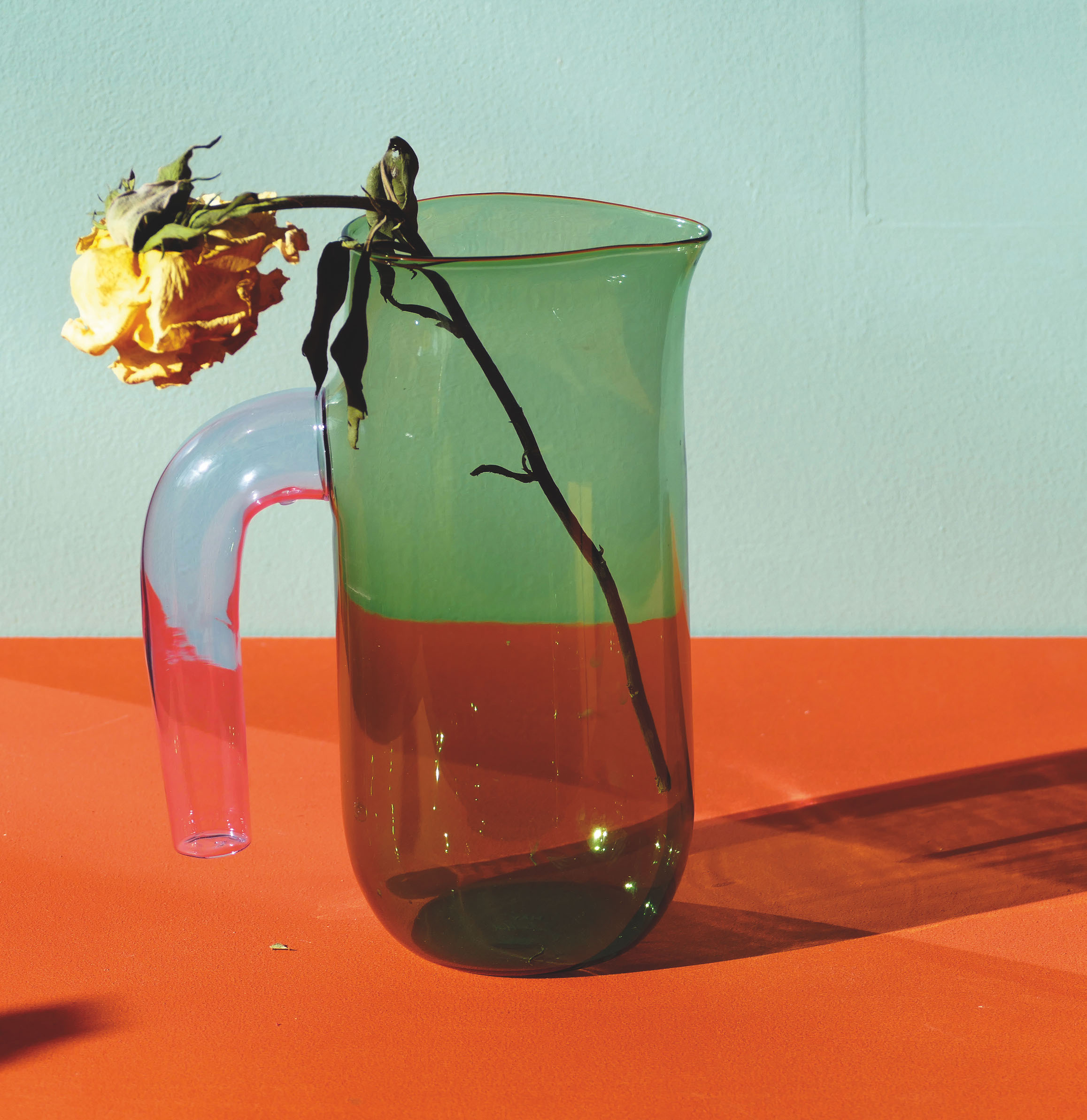A Life Detained: Interview with Director Pedro Almodóvar
Portrait of the artist. Courtesy of Marlborough Gallery, New York.
Ashley Yu: I read one of your previous interviews with El País, where you said that you use photography as anxiety medication between writing screenplays. What makes you nervous? At what point in your directorial process do you have to take a break and pick up a camera?
Pedro Almodóvar: The process happens spontaneously. I plan nothing and organize nothing. The writing process is really tough. It’s tense. Not only because it’s very solitary, but you’re also really grappling and...[mimics wrestling with his hands] fighting with the different elements of drama that you have to put into place to conform into a narrative, a plot line to a movie. That is the toughest aspect in the process of creating a movie. The point where you’re grappling with all these elements is the point when you’re closest to the abyss. You’re doing all this and it’s very uncertain because you don’t know where the edge of the abyss will take you; and you don’t know if it’s going to take you to something that you’d end up liking.
I want to say, that the use of photography as anxiety relief is more of a side effect. It wasn’t intended that way. The photographs all came about from looking at the space around me; looking at the objects surrounding me; studying the way the light would fall naturally on those objects. And I fell in love by arranging these objects into small groups, allowing the natural sunlight to fall on them in a specific, special way. That’s how it came about.
Ashley: What inspired you to take your first photograph?
Almodóvar: It was initially spurred by this exhibition I saw—an exhibition on Spanish realist painters. I saw this exhibition when I was in Spain. Antonio Lopez was one of those painters and you can see one of his works in the big exhibition. When I got home, the first photograph that I took was of just a flower in a glass. It was very simple. I liked it so much that it inspired me to start working with more objects. It all depended on the light: where the light will be, when the light will be there, and when the light will leave.
One thing that is abundant in my home is objects. I have hundreds of objects in my home that I have gradually rediscovered as I put them in front of the lens. I buy many things when I’m traveling, like in New York. That vase [points to picture on display at the back of the room], I bought it in Soho. I buy many small things that I know would be present in my future movies. I could make this exhibition because I have all these vases at home.
© Pedro Almodóvar, Menina, 2019. Digital print on cotton paper mounted on aluminium dibond, ed. of 3. 39 3.8 x 28 3/4 in, 100 x 73 cm. Courtesy Marlborough Gallery, New York
Ashley: With all of these objects in your home, are there any certain lucky talismans or tokens that you like to surround yourself with to kickstart your creativity when you write or take photographs?
Almodóvar: No, no, no. In fact, many friends have given me talismans over the years. I have a necklace with a special stone, and it was a gift from Chavela Vargas—a Mexican singer, she is one of my muses that I really miss. My friends would give me these talismans as protection but it makes me remember things from the past, from another life, instead. I’m not a believer. I am not superstitious. I actually feel extremely lonely and unprotected because I don’t fall for these things people usually fall for: talismans, holy images, religion. I’ve never fallen for them. So I do feel extremely exposed, vulnerable, and…lonely [chuckles], because I have none of these protections. Yet I am very grateful for the light, the light that falls on the objects and creates a certain beauty. It is that beauty that I pursue and that is my talisman.
Ashley: Though you don’t “fall for” these religious imagery and such, there is a lot of spiritual undertones in your exhibition today. You’ve described your photographic compositions as “altars” and even the title of this exhibition, “Waiting for the Light”, could be interpreted as religious. Does spirituality play into your creative practice and why?
Almodóvar: It absolutely does. The fact that I don’t believe in organized religion does not mean that I’m not spiritual, that I am not a humanist. On the contrary, there is a lot of spirituality and humanism in what I do. In many of my photographs, that is precisely what I am celebrating: the way the light defines the moment, like a holy epiphany—it is an epiphany of a light that falls onto something and converts it to something beautiful. These epiphanic moments are all moments of intimacy, for me. The fact that I’m not a believer doesn’t mean that I don’t see spirituality in the things I do and in the things I see.
© Pedro Almodóvar, Explosion of Spring 2, 2018. Digital print on cotton paper mounted on aluminium dibond, ed. of 3. 37 3/4 x 39 3/8 in, 96 x 100 cm. Courtesy Marlborough Gallery, New York
Ashley: So still life photography translated into Spanish is la vida detenida.
Almodóvar: Yes, that’s right.
Ashley: But that phrase translates more closely to “a life detained.” What does still-life photography and that phrase mean to you?
Almodóvar: I likes the term more—la vida detenida—because it is a lot more representative of what I am aiming for. There is another word in Spanish, bodegón, that has a much more sort of connotations with food. La vida detenida is more suggestive and more real.
Ashley: In what sense is it more suggestive and more real?
Almodóvar: The usual translation of still-lifes into Spanish is bodegón. But that word in Spain invokes alcohol, drinking. It invokes a bodega, like a store or a pantry. But la vida detenida pertains to objects, inanimate objects that stay still in front of a camera. Even phonetically, it is much more suggestive than bodegón and seems more urgent and immediate. Also because la vida detenida is not well translated to English. You know how when you take photo of someone, a portrait or…what you call it…[raises his hand up and mimics clicking a camera]
Ashley: A selfie?
© Pedro Almodóvar, Backgrounds in Movement 1, 2019. Digital print on cotton paper mounted on aluminium dibond, ed. of 3. 29 1/2 x 20 1/4 in, 75 x 51.5 cm. Courtesy Marlborough Gallery, New York
Almodóvar: A selfie, yes. Any kind of photo…you stop for a moment. And I love that stillness, la quietud.
That stillness and standing still is an element that appears in photographs and portraits. Take family portraits, for instance. All of them have to stand so still for a second in front of the camera before the shutter goes off. The human subjects pose for the camera in absolute stillness and it is the same here with the inanimate objects. My photographs are as if the objects in the images have stood still and are posing for the camera; as if I’ve interrupted that life flow, at least for a moment. Of course, in this case, we don’t think there’s much of a life flow here because they’re all fruits, flowers, vases and such. But for me, there is an existing element of stillness, la quietud in the images, like in a family portrait. That is what I like capturing that quietud and those still-life photos.
© Pedro Almodóvar, Reds, 2018. Digital print on cotton paper mounted on aluminium dibond, ed. of 3. 36 3/8 x 39 3/8 in, 92.5 x 100 cm. Courtesy Marlborough Gallery, New York
Ashley: Speaking of portraits, I’ve also read that you wanted your images to imitate paintings, more than photographs. What do you mean by that?
Almodóvar: Yes. Let’s say the moment I took that first picture, I was thinking about realistic and hyper-realistic paintings—paintings, not hyper-realistic photographs. What pleases me, at least in these pictures, is that they’re painterly. The fact that I was waiting for the light at the end of the day also made it seem more like a realistic painting. Even though there are many photographers that I admire, in my eyes, I was not thinking of photographers or making references to them. Bodegón is solely a painterly theme, which includes paintings of flowers and vases. That is ultimately a classical element in that genre. I wanted to imitate and manipulate the photos to look like paintings. I was really going for the painterly aspects of pictorial images.
Ashley: You’ve mentioned Morandi and Antonio Lopez, and Sanchez Cotán as lot of your inspirations for your work. What qualities of their work that inspires your own?
Almodóvar: Yes, Lopez and Cotán applied more to my first exhibition, “A Life Detained,” and you’ll also see one of Antonio Lopez’s pieces in this show. But someone like Antonio Lopez, for instance, tries to capture reality as it is and that is an unachievable goal. But the emotion he emotes in the process of capturing reality is phenomenal. So I’m searching for that same kind of emotion. Unlike the vida detenida images, I was thinking about artwork by those, such as Morandi and David Hockney, more so than that of Lopez —though Lopez is an absolutely great painter. He was an amazing painter of flowers. Incredible. The emotion that he captures in sketching flowers that he transmits is extremely powerful.
© Pedro Almodóvar, Multiple Background 1, 2019. Digital print on cotton paper mounted on aluminium dibond, ed. of 3. 29 3/4 x 22 7/8 in, 75.5 x 58 cm. Courtesy Marlborough Gallery, New York
Ashley: What’s different about when you shoot movies and when you shoot photographs, if it’s even comparable at all?
Almodóvar: No, you cannot compare them. Primarily, I wanted to communicate, through the photos, the emotion of my solitude, soledad. These photographs capture a single moment and in a domestic space. A film is absolutely contrary to that. You are trying to film people, directed in a way, that is usually hyper-technical. There are no comparisons, neither in the way you hold the camera, nor with the material. The photograph is just an image. A movie is hundreds of images. A movie is like a literary photograph that you can create, that is possible for you to make. But the elements that [film and photography] provoke are completely distinct. Above all, the distinction is that you’re either filming people or that you’re completely alone.
Ashley: Last question, just to take it easy: What’s your favorite flower?
Almodóvar: [laughs] Gerbera? I don’t know what it is in English. Red gerberas. [He leafs through a catalogue of his images and points to the image of the flower.] This is an almost destroyed Gerbera. This is not completely fresh. It’s like an oversized variation of a daisy. I’d say that is one of my favorite flowers. And carnations. Carnations are very Spanish, especially the red ones. But more than the red carnations, I like the pink carnations the most.
© Pedro Almodóvar, Change of Base 1, 2018. Digital print on cotton paper mounted on aluminium dibond, ed. of 3. 39 3/8 x 38 1/4 in, 100x 97 cm. Courtesy of Marlborough Gallery, New York














